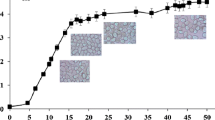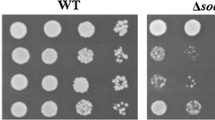Abstract
In this study we investigated the effects of exogenous and endogenous oxidative stress on mitochondrial membrane permeability transition in yeast cells. E. magnusii yeast was used in the study as it is the only yeast strain possessing a natural high-capacity Са2+ transport system. The key reactive oxygen species (ROS) detoxifying enzymes in the yeast cells - catalases (CATs) and superoxide dismutases (SODs) - were fully characterized. At least five isoforms of SODs and only one isoform of CATs were found in the E. magnusii mitochondria. The assessment of the main properties of mitochondrial non-specific permeability under physiological conditions such as dynamics of the membrane potential (∆Ψ) and swelling in mitochondria showed that under physiological conditions classical inhibitors of CATs (ATZ - 3-amino-1, 2, 4-triazole) and of SODs (DDC - diethyldithiocarbamate) caused irreversible decline in ∆Ψ in the yeast mitochondria. This decline was accelerated in the presence of 500 μM Са2+. The combined action of the inhibitors (ATZ + DDC) promoted moderate swelling in the isotonic medium, which was confirmed by transmission electron microscopy. Mitochondrial swelling in the cells exposed to antioxidant system inhibitors was accompanied by typical signs of early apoptosis, namely by chromatin margination and condensation, vacuolization of the cytosol, and damage of the plasma membrane. Here we showed, at both cellular and mitochondrial levels, that the deregulation of oxidant-scavenging enzymes directly leads to the opening of the mPTP, followed by induction of apoptotic markers in the whole yeast cells. Our studies are the first to clarify the highly contradictory data in the literature on mPTP in yeast mitochondria.
Similar content being viewed by others
References
Åkerman KEO, Wikström MKF (1976) Safranine as a probe of the mitochondrial membrane potential. FEBS Lett 68:191–197
Azzolin L, von Stockum S, Basso E, Petronilli V, Forte MA, Bernardi P (2010) The mitochondrial permeability transition from yeast to mammals. FEBS Lett 584:2504–2509
Balcavage WX, Lloyd JL, Matton JR, Ohnishi T, Scarpa A (1973) Cation movements and respiratory response in yeast mitochondria treated with high Ca2+ concentrations. Biochim Biophys Acta 305:41–51
Bazhenova EN, DeryabinaYI EO, Zvyagilskaya RA, Saris N-EL (1998) Characterization of a high-capacity calcium transport system in mitochondria of the yeast Endomyces magnusii. J Biol Chem 273:4372–4377
Bernardi P (1999) Mitochondrial transport of cations: channels, exchangers, and permeability transition. Phys Rev 79:1127–1155
Bradford MM (1976) A rapid and sensitive method for the quantitation of microgram quantities of protein utilizing the principle of protein-dye binding. Anal Biochem 72:248–254
Brookes PS, Yoon Y, Robotham JL, Anders MW, Sheu SS (2004) Calcium, ATP, and ROS: a mitochondrial love-hate triangle. Am J Physiol Cell Physiol 287:C817–C833
Cabiscol E, Piulats E, Echave P, Herrero E, Ros J (2000) Oxidative stress promotes specific protein damage in Saccharomyces cerevisiae. J Biol Chem 275:27393–27398
Carafoli E, Balcavage WX, Lehninger AL, Matton JR (1970) Ca2+ metabolism in yeast cells and mitochondria. Biochim Biophys Acta 205:18–26
Costa V, Amorim MA, Reis E, Quintanilha A, Moradas-Ferreira P (1997) Mitochondrial superoxide dismutase is essential for ethanol tolerance of Saccharomyces cerevisiae in the post-diauxic phase. Microbiology 143:1649–1656
Crompton M (1999) The mitochondrial permeability transition pore and its role in cell death. Biochem J 341:233–249
Davis BJ (1964) Disc electrophoresis. II. Method and application to human serum proteins. Ann NY Acad Sci 121:404–407
Demasi APD, Pereira GAG, Netto LES (2006) Yeast oxidative stress response. Influences of cytosolic thioredoxin peroxidase I and of the mitochondrial functional state. FEBS J 273:805–816
Deryabina YI, Bazhenova EN, Zvyagilskaya RA (2000) The Ca2+-Transport system of yeast (Endomyces magnusii) mitochondria: independent pathways for Ca2+ uptake and release. Biochem Mosc 65:1352–1356
Deryabina YI, Bazhenova EN, Saris NE, Zvyagilskaya RA (2001) Ca(2+) efflux in mitochondria from the yeast Endomyces magnusii. J Biol Chem 276(51):47801–47806
Deryabina YI, Isakova EP, Shurubor EI, Zvyagilskaya RA (2004) Calcium-dependent non-specific permeability of the inner mitochondrial membrane is not induced in mitochondria of the yeast Endomyces magnusii. Biochem Mosc 69(9):1025–1033
Flohé L, Otting F (1984) Superoxide dismutase assays. Methods Enzymol 105:93–104
Guidot DM, McCord JM, Wright RM, Repine JE (1993) Absence of electron transport (Rho 0 state) restores growth of a manganese-superoxide dismutase-deficient Saccharomyces cerevisiae in hyperoxia. Evidence for electron transport as a major source of superoxide generation in vivo. J Biol Chem 268:26699–266703
Gulbins E, Dreschers S, Bock J (2003) Role of mitochondria in apoptosis. Exp Physiol 88:85–90
Gunter TE, Buntinas L, Sparagna G, Eliseev R, Gunter K (2000) Mitochondrial calcium transport: mechanisms and functions. Cell Calcium 28:285–296
Gunter TE, Yule DI, Gunter KK, Eliseev RA, Salter JD (2004) Calcium and mitochondria. FEBS Lett. 567:96-102
Hajnуczky G, Csordбs G, Das S, Garcia-Perez C, Saotome M, Sinha Roy S, Yi M (2006) Mitochondrial calcium signalling and cell death: approaches for assessing the role of mitochondrial Ca2+ uptake in apoptosis. Cell Calcium 40:553–560
Halliwell B, Aruoma OI (1991) Mitochondrial calcium signalling and cell death: approaches for assessing the role of mitochondrial Ca2+ uptake in apoptosis. FEBS Lett 281:9–19
Han D, Williams E, Cadenas E. (2001) Mitochondrial respiratory chain-dependent generation of superoxide anion and its release into the intermembrane space. Biochem. J 353:411–416
Hansford RG, Zorov D (1998) Role of mitochondrial calcium transport in the control of substrate oxidation. Mol Cell Biochem 184:359–369
Herrero E, Ros J, Bel G, Cabiscol E (2008) Redox control and oxidative stress in yeast cells. Biochim Biophys Acta 1780:1217–1235
Jung DW, Bradshaw PC, Pfeiffer DR (1997) Properties of a cyclosporin-insensitive permeability transition pore in yeast mitochondria. J Biol Chem 272:21104–21112
Kostyuk VA, Potapovich AI, Kovaleva JV (1990) A simple and sensitive method of determination of superoxide dismutase activity based on the reaction of quercetin oxidation. Vopr Med Chim 2:88–91
Kovaleva MV, Sukhanova EI, Trendeleva TA, Zyl’kova MV, Ural’skaya LA, Popova KM, Saris NE, Zvyagilskaya RA (2009) Induction of a non-specific permeability transition in mitochondria from Yarrowia lipolytica and Dipodascus (Endomyces) magnusii yeasts. J Bioenerg Biomembr 41(3):239–249
Kowaltowski AJ, Vercesi AE (1999) Mitochondrial damage induced by conditions of oxidative stress. Free Radic Biol Med 26:463–471
Kowaltowski AJ, Vercesi AE, Rhee SG, Netto LE (2000) Catalases and thioredoxin peroxidase protect Saccharomyces cerevisiae against Ca(2+)-induced mitochondrial membrane permeabilization and cell death. FEBS Lett 473:177–182
Kowaltowski AJ, de Souza-Pinto NC, Castilho RF, Vercesi AE (2009) Mitochondria and reactive oxygen species. Free Radic Biol Med 47:333–43
Kroemer G, Galluzzi L, Brenner C (2007) Mitochondrial membrane permeabilization in cell death. Physiol Rev 87:99–163
Lemasters JJ, Theruvath TP, Zhong Z, Nieminen AL (2009) Mitochondrial calcium and the permeability transition in cell death. Biochim Biophys Acta 1787:1395–1401
Leung AWC, Halestrap AP (2008) Recent progress in elucidating the molecular mechanism of the mitochondrial permeability transition pore. Biochim Biophys Acta 1777:946–952
Lledias F, Rangel P, Hansberg W (1998) Oxidation of catalase by singlet oxygen. J Biol Chem 273:10630–10637
Lopez-Mirabal HR, Winther JR (2008) Redox characteristics of the eukaryotic cytosol. Biochim Biophys Acta 1783:629–640
Lushchak VI (2011) Adaptive response to oxidative stress: bacteria, fungi, plants and animals. Comp Biochem Physiol C Toxicol Pharmacol 153:175–190
Matrosova EV, Masheyka IS, Kudryavtseva OA, Kamzolkina OV (2009) Morphogenesis and ultrastructure of basidiomycetes Agaricus and Pleurotus mitochondria. Cell and Tissue Biology 3(4):369–380
McCormack JG, Denton RM (1994) Signal transduction by intramitochondrial Ca2+ in mammalian energy metabolism. News Physiol Sci 9:71–76
Nicholls DG, Ferguson SJ (1992) Bioenergetics 2. Academic, San Diego
Ojovan SM, Knorre DA, Severin FF, Bakeeva LE (2009) Yeast cell ultrastructure after amiodarone treatment. Tsitologiya 51(11):911–916
Peng TI, Jou MJ (2010) Oxidative stress caused by mitochondrial calcium overload. Ann NY Acad Sci 1201:183–188
Perrone GG, Tan SX, Dawes IW (2008) Reactive oxygen species and yeast apoptosis. Biochim. Biophys Acta 1783:1354–1368
Rasola A, Bernardi P (2007) The mitochondrial permeability transition pore and its involvement in cell death and in disease pathogenesis. Apoptosis 12:815–833
Reynolds ES (1963) The use of lead citrate at high pH as an electron opaque strain in electron microscopy. J Biophys Biochem Cytol 17:208
Scherz-Shouval R, Elazar Z (2011) Regulation of autophagy by ROS: physiology and pathology. Trends Biochem Sci 36:30–38
Streiblova E (1988) Cytological methods. In: Campbell J, Buffers JM (eds) Yeast – A Practical Approach, IRL Press, Oxford, pp 9–49
Trendeleva T, Sukhanova E, Ural’skaya L, Saris NE, Zvyagilskaya R (2011a) Mitochondria from Dipodascus (Endomyces) magnusii and Yarrowia lipolytica yeasts did not undergo a Ca(2+)-dependent permeability transition even under anaerobic conditions. J Bioenerg Biomembr 43(6):623–631
Trendeleva T, Sukhanova E, Ural’skaya L, Saris NE, Zvyagilskaya R (2011b) Effect of pro-oxidants on yeast mitochondria. J Bioenerg Biomembr 43(6):633–644
Tsujimoto Y, Shimizu S (2007) Role of the mitochondrial membrane permeability transition in cell death. Apoptosis 12:835–840
van Loon AP, Pesold-Hurt B, Schatz G (1986) A yeast mutant lacking mitochondrial manganese-superoxide dismutase is hypersensitive to oxygen. Proc Natl Acad Sci USA 83:3820–3824
Yamada A, Yamamoto T, Yoshimura Y, Gouda S, Kawashima S, Yamazaki N, Yamashita K, Kataoka M, Nagata T, Terada H, Pfeiffer DR, Shinohara Y (2009) Ca2+-induced permeability transition can be observed even in yeast mitochondria under optimized experimental conditions. Biochim Biophys Acta 1787:1486–1491
Author information
Authors and Affiliations
Corresponding author
Rights and permissions
About this article
Cite this article
Deryabina, Y., Isakova, E., Antipov, A. et al. The inhibitors of antioxidant cell enzymes induce permeability transition in yeast mitochondria. J Bioenerg Biomembr 45, 491–504 (2013). https://doi.org/10.1007/s10863-013-9511-2
Received:
Accepted:
Published:
Issue Date:
DOI: https://doi.org/10.1007/s10863-013-9511-2




